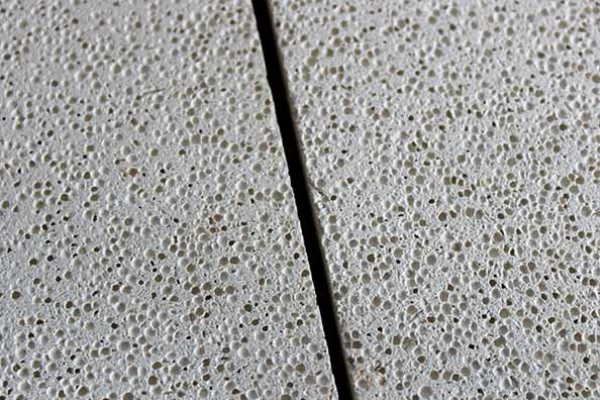
Corundum - Mullite samtempe kun Corundum kaj Mullite du bonegaj prezentoj.
Pora ceramiko estas speco de ceramika materialo, kiu konsistas el multnombraj poroj aranĝitaj en spaco diversmaniere.
Pora ceramiko laŭ la poro -grandeco povas esti dividita en krudan aperturon pora ceramiko (poro -diametro > 500μm) Granda aperturo pora (500μm > poro -diametro > 100μm), pora ceramiko en la aperturo (100μm > poro -diametro > 10μm), pora ceramiko en la malgranda aperturo (10μm > poro -diametro > 1μm), Pora ceramiko (poro -diametro < 1μm).
La strukturo de la poroj en la ceramiko povas esti dividita en malferman poro -pora ceramiko, fermita poro -ceramiko, kaj penetranta pora ceramiko. Poraj ceramikoj havas unuforme distribuitajn porojn aŭ multajn penetrantajn porojn, kun alta permeablo. Estas multaj poroj en la matrico, do ĝi havas malgrandan pograndan densecon.
Pora ceramiko evoluinta kun specifaj surfacoj povas produkti unikajn fizikajn surfacajn proprietojn kaj formiĝi sur la likva kaj gasa amaskomunikilaro selektema permeablo, dum plue reduktante la termikan konduktivecon de ceramiko.
Samtempe, Ceramikaj materialoj havas unikan alt-temperaturan reziston, koroda rezisto, Alta kemia stabileco, kaj dimensia stabileco, pora ceramiko kiel nova speco de materialo rapide disvolviĝis.
Nuntempe, Pora ceramiko estas uzata en gasaj sensiloj, katalizaj portantoj, Filtriloj por varmaj gasoj aŭ fanditaj metaloj, kaj alt-temperaturaj refraktaj izolaj materialoj. Kiel katalizaj portantoj, Pora ceramiko havas la avantaĝojn de alt-temperatura rezisto, koroda rezisto, Neniu poluado de katalizilo, kaj malalta kosto kompare kun aliaj katalizaj portantoj.
Malpeza Mullite -refraktaj brikoj Por multite ĉefa kristala fazo de altaj alumina refraktaj materialoj, ĝenerala alumina enhavo inter 65% -75%. Mullite lightweight refractory bricks’ refractory temperature can reach more than 1790 ℃. Ŝarĝi mildigante komencan temperaturon de 1600-1700 ℃. Bona termika ŝoka rezisto.
Malpezaj poraj mullitaj brikoj havas malgrandan densecon, granda specifa surfaco, malalta termika konduktiveco kaj koeficiento de termika ekspansio, Alta fandpunkto, kaj bona koroda rezisto, kaj havas tre larĝan aplikan perspektivon en la kampo de alt-temperatura termika izolado, Filtrado, kataliza kaj tiel plu.
Mullite -brikoj faritaj el mullito kiel la ĉefa kruda materialo, kun alt-temperatura forto, malalta rampa indico, malalta termika ekspansio, forta kemia erozia rezisto, kaj bona termika ŝoko rezisto, ktp., uzeblas por varma aera forna volbo kaj brula ĉambro en la mezo kaj supra, sed ankaŭ por ceramikaj brulaj brikoj.
Nuntempe, Alt-purecaj mullitaj refraktaj brikoj estas uzataj en diversaj alt-temperaturaj fornaj tegaĵoj, inkluzive de fornaj fornoj, Eksplodaj fornoj, Varma fero verŝante kavojn, kaj kontinua gisado de forno -tegaĵoj.
Mullite-bazitaj stanaj banaj brikoj estas ŝlosila refrakta materialo por flosantaj vitraj fornoj ĉe la muldita stadio.
Corundum – mullite at the same time with corundum and mullite two excellent performances. Ĝi estas altkvalita refrakta materialo kun alta temperatura rezisto, alta mekanika forto, rezisto al skurĝo, erozio, bona termika ŝoko rezisto, kaj malgranda nebuleca efiko, kiu estas vaste uzata en alt-temperaturaj fornoj.
Mulllite-cordierite estas sinterita per mullito kiel agregita kordierito kiel la bazmaterialo. La termika ekspansia koeficiento de kordierite -bazmaterialo estas pli malgranda ol tiu de mullilita agregato. Pro la miskompreno de iliaj koeficientoj de ekspansio, mikrokraĉoj formiĝas, La malmoleco de la mullite-cordierite-materialo estas plibonigita, kaj la termika stabileco de la mullite-cordierite-forno estas plibonigita.
Mullite-kordieritaj materialoj havas bonegan termikan ŝokan reziston kaj bonan alt-temperaturan agadon kaj estis ofte uzataj en ceramikaj fornaj mebloj de hejmaj kaj eksterlandaj fabrikantoj.
Laŭ refrakta Multaj jaroj da sperto diras al vi tion. Kun ĝia malpeza kaj bonega termika izolado, Mullite malpezaj refraktaj brikoj estas vaste uzataj en la varma surfaco refrakta tegaĵo aŭ termika izola tavolo de multaj specoj de termika ekipaĵo, kiu kreas kondiĉojn por plibonigi la energian uzadon de la ekipaĵo. Mullite malpeza refrakta briko povas esti uzata kiel varma surfaca refrakta tegaĵo aŭ alia refrakta apogila izola tavolo, uzata en petrolo, Kemia industrio, etilen -fendanta forno, tubo hejtanta forno, amonia konvertiloj, Gasaj fornoj, alt-temperaturaj navedaj fornoj, tunelaj fornoj, ceramika rulseĝo, puŝu platan fornon kaj aliajn industriajn fornon forno varmaj izolaj materialoj kaj tiel plu.
La uzo de malsamaj temperaturoj estas ĉefe dividita en 1350 malpezaj mulitbrikoj, 1450 mullite izolaj brikoj, 1550 Mullite malpezaj brikoj, Kaj tiel plu.
Since October, alumina prices have continued to rise, and China's largest bauxite importer - a…
First, Alta Alumina Briko: The Leader In High Temperature Refractories As a leader in high-temperature…
The application of refractory bricks in the kiln immediately endangers the operation rate of the…
Analysis Of The Causes Of Common Quality Problems In Tunnel Kiln Construction And Measures To…
Corundum quality refractory castables are made from corundum to the new jade refractory insulation material…
Analysis Of Aluminum-Silicon Refractory Raw Materials Prof. Li Yong of the University of Science and…